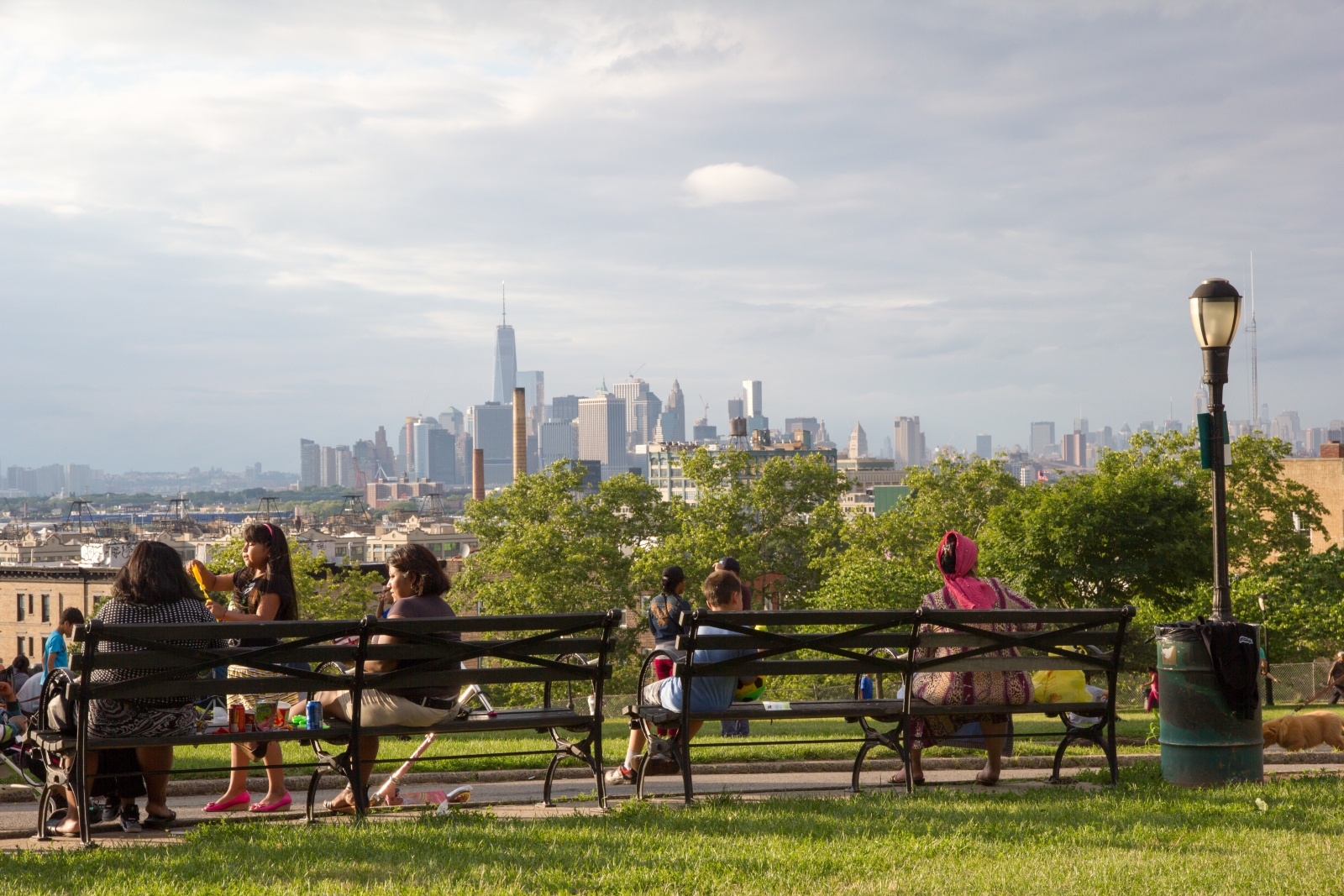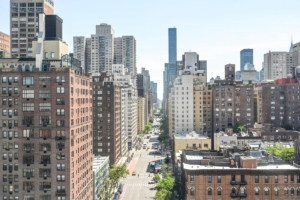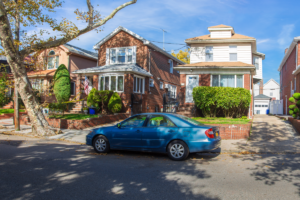
Families in Sunset Park, Brooklyn. The borough is one of the most affordable places in NYC to add a second bedroom.
Expanding your family is a joy, but having children can be financially challenging. This is acutely true for New Yorkers, who face high housing prices and are twice as likely to rent than the average American household. In New York City, 63 percent of households rent their homes, relative to 32 percent of households nationwide [1]. While buying a home before starting a family is often seen as a rite of passage in the U.S., New York City parents are actually more likely to rent (68 percent) than own (32 percent), and no more likely to own than the average New York City household. High rents and the financial demands of raising children lead many New Yorkers with children to rent only the space that they need. As a result, New Yorkers expanding their families have tough choices to make when finding a home for their growing household. Census data shows that a crowded, populous borough like Manhattan has relatively few children:
|
Homeownership and Parenthood in NYC [1] |
||||||
| Bronx | Brooklyn | Manhattan | Queens | Staten Island | NYC | |
| Homeownership – Overall | 19% | 30% | 23% | 44% | 71% | 32% |
| Total Households (HHs) | 498,539 | 941,871 | 748,293 | 761,819 | 164,289 | 3,114,811 |
| Share of HHs w/ children | 37% | 30% | 18% | 31% | 36% | 29% |
| Homeownership – HHs with Children | 14% | 30% | 27% | 43% | 71% | 32% |
| Homeownership – HHs without Children | 22% | 29% | 22% | 45% | 70% | 32% |
[1] Ibid.
We looked at the New York City boroughs and neighborhoods offering the easiest financial transitions for families looking for homes with an additional bedroom. For each of these neighborhoods, we calculated the difference in rent New Yorkers can expect to pay for a home with an additional bedroom, and the change in the amount of rental inventory when looking at larger living options. Of course, these are only a few of the factors that a family may consider in selecting a home. There are housing options for families in all NYC boroughs, and choosing a home will depend on individual priorities.
Brooklyn Offers Easiest Financial Transition for Renters Expecting Their First Child
According to our analysis, Brooklyn is an excellent borough for those expanding their family in the near future. Families searching for a home with an additional bedroom in Brooklyn face the smallest price increases as a share of current asking rents: The median asking rent for 2-bedroom apartments increases 14 percent from the median asking rent of studio and 1-bedroom apartments, compared to a 32 percent increase in Manhattan. While the supply of 2-bedroom apartments is lower than that of studio and 1-bedroom apartments across the city, the drop in inventory in Brooklyn is also the smallest of the five boroughs. The inventory of 2-bedrooms is 12 percent lower than that of 1-bedrooms and studios, whereas Manhattan 2-bedroom inventory is 56 percent smaller than 1-bedroom and studio inventory. Bushwick stands out among Brooklyn neighborhoods with abundant 2-bedroom rental inventory and apartments that ask 13 percent more for 2-bedrooms than a studio or 1-bedroom. East New York, Red Hook, Sunset Park, and Bedford-Stuyvesant also offer relatively affordable 2-bedroom homes compared to studios and 1-bedrooms.
Queens neighborhoods come in a close second for New Yorkers looking to upgrade from a studio or 1-bedroom. Ridgewood, where we estimate that one out of three households has children, has double the number of 2-bedroom units compared to the combined inventory of studios and 1-bedrooms. Overall, Queens has four neighborhoods — Ridgewood, Glendale, Middle Village, and Kew Gardens Hills — with more 2-bedroom options than studios or 1-bedrooms. Of the Queens neighborhoods we analyzed, Long Island City also stands out for requiring only 6 percent more rent for the median 2-bedroom unit compared to the median studio or 1-bedroom unit.
Your Second Child May Not Be as Costly as Your First
| Space-Friendly New York Neighborhoods | ||||
|---|---|---|---|---|
| Easy to Find (Smallest Drop in Inventory) | Less Cost-Burdened (Smallest Increase in Rent) | |||
| Studio/1-Bed to 2-Bed | 2-Bed to 3-Bed | Studio/1-Bed to 2-Bed | 2-Bed to 3-Bed | |
| 1 | Belmont | Bayside | Long Island City | Midtown South |
| 2 | Bushwick | Canarsie | Williamsburg | Fort Greene |
| 3 | Ridgewood | West Harlem | Greenwood | Flushing |
| 4 | East New York | Ridgewood | Bushwick | Chelsea |
| 5 | Glendale | East New York | Ridgewood | Glendale |
For renters seeking a third bedroom, options narrow dramatically. Only six neighborhoods in New York City offer more 3-bedroom inventory than 2-bedroom inventory: East New York, Canarsie, Bayside, Ridgewood, North New York and West Harlem. However, at least in Manhattan and Queens, the price impact of seeking a third bedroom is lower on a percentage basis than adding second bedroom.
While Manhattan has the highest rental inventory drop between 2-bedroom and 3-bedroom units (a decline of 63 percent), some of the borough’s neighborhoods provide a relatively affordable transition from 2 to 3 bedrooms. Midtown South, Chelsea and Stuyvesant Town/Peter Cooper Village have the smallest rent increases in Manhattan when adding third bedroom (-5 percent, 11 percent and 13 percent respectively). However, those looking to add a third bedroom in the Upper East Side can expect an 83 percent jump in rent. In Flushing, Queens, 3-bedroom homes rent for an average of 11 percent higher than 2-bedroom homes, while trading up from a smaller unit to a 2-bedroom will incur a 33 percent increase. In Glendale, a second bedroom will cost 22 percent more, while adding a third bumps up the median rent by 13 percent.
How We Did It
Median asking rent and total inventory are calculated using homes listed for rent on StreetEasy from November 2016 to October 2017. We used the 2016 1-year American Community Survey (ACS) to estimate the homeownership rate of households and the share of households with children in each borough, and the 2015 5-year ACS to estimate the share of households with children in each neighborhood. Neighborhoods included in this analysis had at least 50 rentals available between November 2016 and October 2017.
[1] 2016 1-year American Community Survey (ACS).
[2] Ibid.
—
Hey, why not like StreetEasy on Facebook and follow @streeteasy on Instagram?









